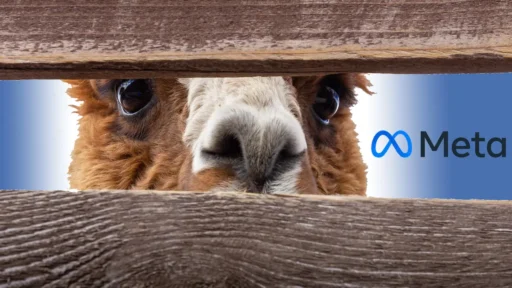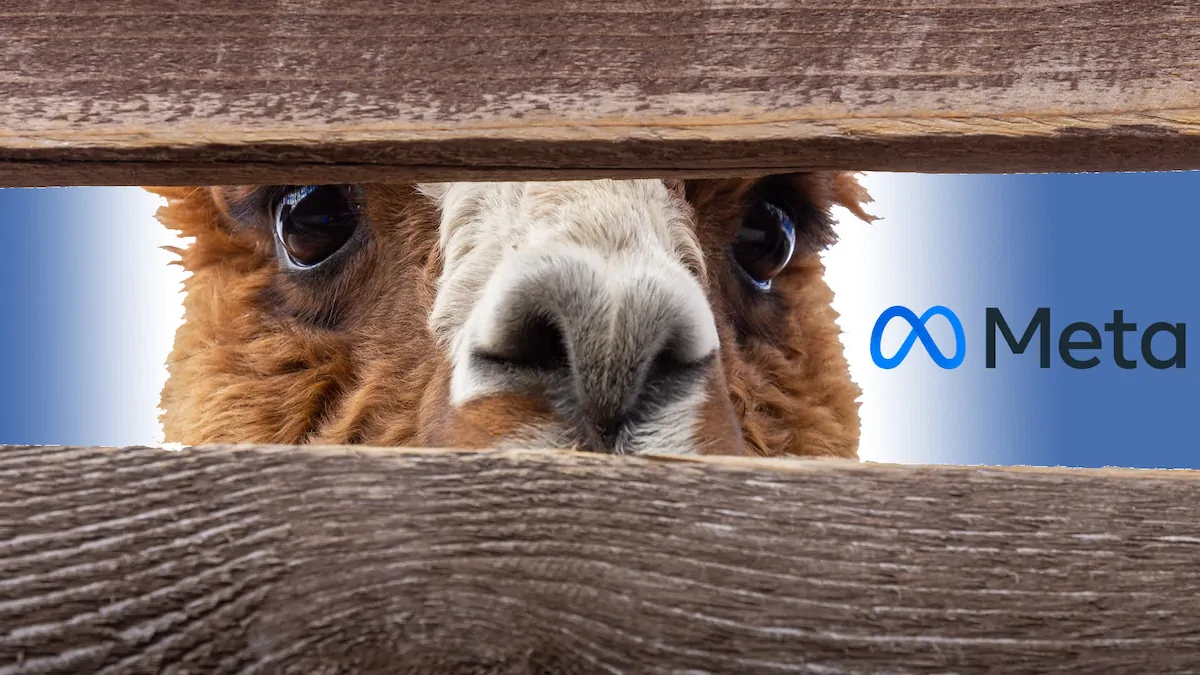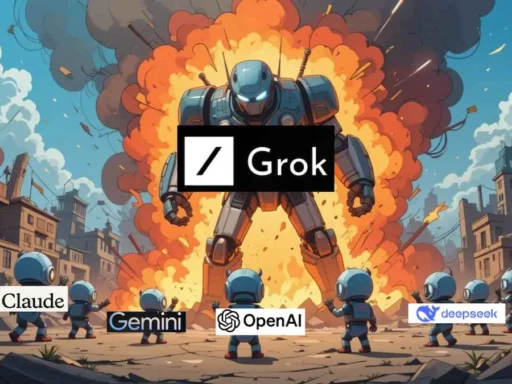So you’ve probably heard the buzz: Llama 4 was supposed to be Meta’s ace in the AI race—and now… it’s nowhere.
People are asking: What’s going on? Where’s the model? Did Meta miss the memo that OpenAI just dropped GPT-4-turbo while Anthropic flexed with Claude 3?
Let’s clear the noise.
We’re peeling back the layers on what’s actually happening behind closed doors at Meta, why their most hyped language model isn’t here yet, and what that delay means for the future of generative AI—both inside Meta and across the industry.
We’re talking scale problems, performance bottlenecks, environmental heat maps, and internal questions that no Silicon Valley PR doc wants to touch.
If you’re a dev, investor, founder, or just a curious mind watching this space, read close.
Because this delay? It’s a signal.
It’s not just a missed deadline—it’s a spotlight on tech’s next real battle: growth vs. ethics, scale vs. responsibility, speed vs. stability.
What The Llama Series Means For Meta’s AI Strategy
Meta didn’t build the Llama series to play nice.
It was a counter move.
OpenAI had GPT-3 sweeping the board, Google had Bard warming up, and then Meta said, “Cool. Meet our open-source family.”
LLaMA 1 came with solid research benchmarks. LLaMA 2 turned into an API for edge devs, small labs, and the weird corner of open-source communities obsessed with trimming token limits.
These models weren’t just science experiments—they were strategic chess pieces.
By letting some versions go open-source, Meta positioned itself as the “open alternative” to the lock-box systems from Microsoft-backed OpenAI or Amazon’s proprietary AWS models.
Internally, Llama models fuel:
- AI-generated content pipelines inside Instagram and Facebook
- Built-in moderation and anti-abuse systems
- Meta’s Reality Labs and upcoming metaverse agents
And unlike a lot of AI toys built for demo day hype? These models are infrastructure.
They affect what shows up in your feed, how ads are delivered, and whether WhatsApp starts finishing your sentences with eerie accuracy.
That’s why Llama 4 matters so much. It’s not just the next version—it’s the platform Meta wants to stand on for the next five years of AI dominance.
So Where Is Llama 4? Internal Setbacks And Outside Pressure
Let’s talk about the elephant in the server room.
Llama 4 isn’t out because the engine under the hood isn’t where it needs to be yet.
There’s no cute update delay, no PR campaign ready to smooth it over. Just a quiet stall.
Inside Meta, researchers hit bottlenecks—hard ones.
| Challenge | Impact |
|---|---|
| Scaling issues | Model struggled to stay efficient beyond certain param sizes |
| Training data limits | Need for cleaned, diverse corpora sent timelines backward |
| Inference demands | Llama lagged in real-time responsiveness vs. GPT-4 Turbo |
Add to that the external squeeze:
– OpenAI pushed out GPT-4 Turbo with lower latency and cheaper inference tokens
– Anthropic grabbed headlines with Claude 3’s long-context reasoning
– Google’s Gemini got full integration into Workspace and Android
Everyone’s sprinting.
And Meta? They’re still warming up behind the starting line, triple-checking the blueprint.
Then there’s the weight nobody talks about loud enough—environmental strain.
The power draw needed to train a model like Llama 4 rivals industrial city infrastructure.
Meta’s water usage reports filed in Arizona (see Maricopa County Energy Office documents, 2024 Q1) showed 11.8 million gallons consumed during previous fine-tuning cycles for Llama-class systems.
That’s water levels that make climate advisors sweat.
Also, Meta researchers faced internal friction: should they deploy a half-baked system under pressure or rethink alignment and ethics midstream?
They chose pause over PR points.
Might be the first time a big tech player said no to the hype cycle—but that choice comes with a cost.
Why Llama 4 Still Defines Meta’s Next Chapter
Let me be clear: Meta doesn’t have time to stall forever.
Their ad empire sits on AI personalization.
Their metaverse pipe dream? Needs a language model that can translate thought to conversation to interaction without latency or latency-induced bias.
Reality Labs alone burned through $4B+ last year (Meta Q4 earnings, 2023).
Llama 4 is the literal engine they want powering:
– Spatial AI inside Quest headsets
– AR interface comprehension (customer-to-AI-to-agent relay)
– Long-form conversational agents replacing basic chat scripts
Without it, the whole “ambient computing future” starts looking like vaporware with overpriced VR goggles and undercooked AI brains inside.
Investors? Growing restless. Developers? Looking elsewhere. Startups? Betting on Claude or GPT APIs because they’re live and Llama is not.
But here’s the twist:
Meta knows Llama 4 has to land hard.
Not just as “another model”—but the model with speed, safety, multilingual flex, and environmental restraint baked in.
It’s not about winning with flash—it’s about deploying at scale without fallout.
Because unlike most AI brands, Meta’s real core app is public trust. Lose that? You don’t just delay a product; you delay your future.
Meta Llama 4 Delay: Industry Trends and Implications
AI enthusiasts have been waiting, investors are pacing, and developers keep refreshing GitHub. So where is Meta Llama 4? The delay in launching Meta’s next-generation large language model isn’t just a scheduling hiccup—it’s a red flag waving across the AI industry.
The slowdown reflects deeper tremors: hardware bottlenecks, compute rationing, unresolved training bugs. And here’s a twist—Llama 4’s delay lands during a season where demand for sovereign language models has never been hotter. When Meta’s most anticipated release goes quiet, the silence echoes through boardrooms and hackathons alike.
That bottleneck sends a clear message: not even Big Tech can brute-force its way through the GPU shortage and compute regulation landscape. Llama 4’s limp toward release puts an asterisk beside any ambitious AI roadmap. Think of it as a paused heartbeat in a system that can’t afford one.
Startups, especially those tuned into Meta’s ecosystem, are feeling the crunch. Many baked Llama 4’s capabilities into their investor decks and product pitches. When timelines slip, funding dries up or stalls at due diligence. Accelerator programs are now advising founders to diversify models or “de-risk dependencies”—a polite phrase for “don’t wait on Meta.”
Trickle-down effects look like this: fewer hires, delayed rollouts, and sidelined experiments in real-world environments. Meta-backed ventures are quietly pivoting or pulling back, caught between loyalty to the tech stack and survival instincts. The ripple hits hardest in sectors like climate-tech and mental health AI, where real-world stakes make waiting risky.
To counter the chill, Meta has increased outreach to academic partners. In quiet but telling moves, the company’s AI division has expanded joint projects with institutions like EPFL and Stanford to test auxiliary LLM toolchains and non-English corpora. These aren’t just gestures—they’re sandbags against reputational flood.
Llama 4’s development hiccups are shaping how R&D is distributed. Open science labs once seen as secondary test beds are now de facto lifelines for Meta’s path-to-release simulations. A model’s delay has turned into a reshaping of the AI research network.
Meta’s Role in Startups and Solutions Development
Even with Llama 4 missing in action, Meta’s existing tools still fuel a good chunk of AI startups hustling in the generative space. From Llama 2 deployments to PyTorch’s real-time serving stack, Meta tech has become the engine beneath MVPs across sectors.
Instead of waiting for full-scale models, many startups are patching together slimmed-down LLMs optimized for mobile, on-device inference, or specific domains. This empowers use cases in education, healthcare, and entertainment that wouldn’t survive AWS bills tied to larger closed-shop APIs.
There’s buzz around startups building “niche AI” apps that plug directly into Meta’s infrastructure. Think metaverse-ready companions with Llama cores, customer service avatars in VR, or FinTech copilots built for decentralized spaces. Especially in the EU and LATAM, open-source LLMs align better with regulatory preferences around sovereignty and data traceability.
Here are some examples of real-world experiments happening right now:
- MindLoft – A micro-Llama bot assistant for ADHD users navigating noisy digital calendars.
- AgoraVoice – Leveraging build-your-own Meta pipelines to power multilingual political discourse monologues for civic debates.
- Farmlogic – Layered chatbot trained on agricultural data, deployed offline in drought-affected communities for crop guidance.
Each use case proves something Meta refuses to say outright: even with headline delays, their toolchain hums quietly in underdog projects worldwide.
The Global Impact of Delaying AI Models
When a model like Meta Llama 4 stalls, the headlines focus on tech timelines. But zoom out, and something more troubling surfaces. Entire industries pin their generative pipelines to LLMs that are still circling the runway.
In finance, wealth management firms were trialing Llama-powered copilot apps before compliance use-cases were ever greenlit. With Llama 4 stuck, those experiments collect dust—and user feedback freezes. Meanwhile in mental health, non-profit platforms using Llama 2 for patient journaling analysis say model delays mean a longer stay on less-safe fallback APIs like GPT-3.5.
Environmental scientists face similar issues. On-the-ground projects mapping carbon credits in Amazonian deforestation zones were set to train Llama 4 instances with contextual satellite data. With the delay, they rely on mismatched older LLMs that misread Indigenous locations or hallucinate tree density stats.
And let’s talk about the humans powering all of this. Wages for contract researchers and content moderation assistants—many in the Philippines, Kenya, or Vietnam—are often tied to model refresh cycles. Delays lead to pay cuts or dismissal under ‘overhead optimization,’ a phrase HR teams use when engineers get new GPUs but humans don’t get insurance.
Research assistants attached to AI labs find themselves in limbo, chasing grant renewals that assume a model will launch next quarter. Samplers can’t sample. Annotators can’t annotate. And worst of all? The lag between media buzz and product delivery leads to unproductive ethical debates on AI regulation based on assumptions, not actual deployments.
Let’s be blunt. When flagship models stall, markets don’t slow—they contort. This creates an innovation asymmetry: high-resource orgs can wait out the lull, but scrappy or critical-mission AI teams falter. The longer the delay, the wider the harm gap, especially outside of North America.
Outdated models not only underperform—they make bad assumptions. In justice systems using LLMs to triage public defenders, even a 5% drop in reasoning accuracy translates to life-impacting misjudgments. Prolonging Llama 4 means postponing life-saving AI—quietly and globally.
How Llama 4 Influences Meta’s Future
Is Llama 4 going to fix Meta’s massive bet on generative AI, or will its delay dig a deeper hole? That’s the real question behind the buzz. After years of hyping its large language model ambitions, Meta is now caught mid-sentence — Llama 4 isn’t here yet, and the clock is ticking.
If it launches strong, Llama 4 has the potential to push Meta past its current stall. If it lags or underdelivers, the fallout won’t just hit developers or product teams — it triggers a domino effect across the metaverse, AI research, and revenue goals for AR and ad tech. It could be the moment where Meta either shifts gears or slips further behind.
So what’s next — a meta-transformation, or just another transitional tool like Llama 2?
The future forks here. A powerful Llama 4 could become the AI backbone that breathes life into Meta’s long-term platforms — from Horizon’s virtual worlds to WhatsApp’s AI agents. But delays risk pushing Meta into the rearview mirror, especially as rivals like OpenAI ship every few months.
Buried in sparse updates and PR-safe statements, one strategy is clear: Meta wants to lean hard on Llama 4 as a core engine for their broader AI vision. Expect integrations like:
- Real-time language translation inside VR social hubs
- Hyper-responsive AI characters in metaverse spaces
- Dynamic ads and tools that learn across Meta’s platforms without leaking data to outsiders
But none of that flies if the model stumbles on performance or comes baked with ethical blind spots. Getting Llama 4 right isn’t about bragging rights — it’s about fundamentals: trust, latency, and real-world resilience.
If Meta nails this, Llama 4 could do something the company desperately needs — regain confidence from developers, regulators, and even everyday users burned by past AI misfires. Releasing a trustworthy, reliable, open-weight model at scale could pivot the narrative from “Meta is lagging” to “Meta is leading.”
But every day it’s delayed, competitors march forward. And in this AI arms race, perception hardens fast.
Meta’s Strategic Technology Growth in the AI Market
Let’s cut through the fluff — Meta isn’t building Llama 4 to be a trophy model. They need it to drive partnership deals, advertising innovation, and immersive platform growth. When you look at their verticals — VR, messaging, ads — everything’s riding on tight AI glue.
This isn’t theoretical. Meta’s already rolling out AI tools inside Instagram, Reels, and WhatsApp that lean on older Llama models. Early pilots include dynamic ad generation, sentiment analysis for creator content, and augmented reality overlays. Llama 4 arriving late doesn’t halt the train. But it makes the engine work harder.
Meta talks big on “long-term commitment” to foundational research. But timelines slip, and tight cycles in AI mean a quarter’s delay becomes a whole product lost. Still, the upside is clear if they hold their ground — slower progress might tighten focus. Llama 4 could drop with lower energy demands, tighter bias checks, and customizability that makes OpenAI’s API wall look backward.
Delays aren’t good PR, but they aren’t death sentences either. Sometimes the difference between fragile hype and sustainable growth is just one extra month of validation, one robust tuning framework.
And keep an eye on what Meta learns from its Llama delays — especially as smaller players start stealing mindshare. HuggingFace is democratizing infrastructure, Anthropic is focusing on safety-first AI, and Microsoft is bundling OpenAI’s smarts into enterprise software at hyperscale. Meta doesn’t just need to keep up. It needs to define a lane.
In the long game, Meta still has a shot. With the scale of Facebook and Instagram at its disposal, plus its multi-modal play in VR and wearables, the Llama line could still eat up massive AI terrain if it gets stitched in correctly.
Meta’s Future and Lessons From the Present
Llama 4 delays are frustrating. No one likes missed timelines, especially in a high-stakes race where the expectations are through the roof. But delays give clarity. They reveal what’s broken — not just technically, but organizationally.
Here’s what we’re learning: Meta needs to communicate more like an open platform builder, less like a black-box tech giant. Developers are stakeholders. Researchers are watchdogs. And the world is watching whether the next “open-source” LLM is truly usable — or just a locked garden branded as freedom.
The hurdles Llama 4 faces — compute bottlenecks, data sanitation at scale, hallucination reduction — aren’t just Meta problems. They’re everyone’s problems in AI right now. So the way Meta handles this model’s launch could set real precedents.
Startups watching this aren’t just waiting to copy — they’re watching for caution signs: how to scale fine-tuning without compromising inference time, or how to build guardrails that don’t overcorrect and neuter usefulness.
Here’s the ask: If Meta fixes its launch trajectory, shares insights, and backs up its “open” claims with real documentation — the impact will ripple. More usable community models. Smarter dev tooling. Less gatekeeping in generative AI.
Meta doesn’t need to be first to dominate. But it does need to make this delay count. And if you’re building AI yourself? Pay attention to Llama 4’s stumble. It’s giving away lessons worth billions — for free.





